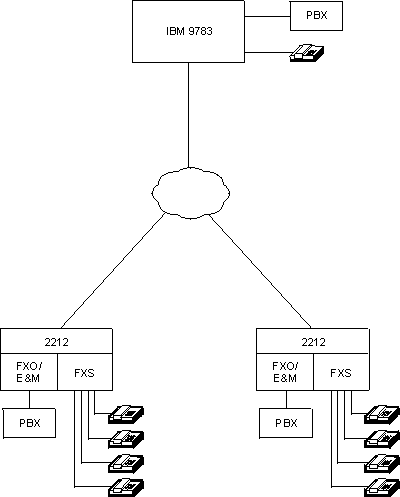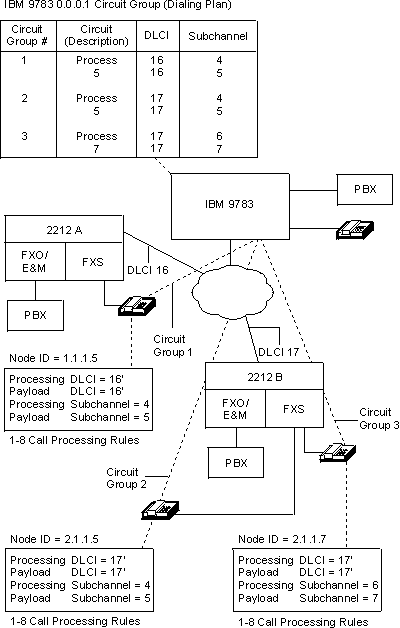

This chapter describes the 2212 voice capabilities, supported adapters, and configuration options.
This chapter includes the following sections:
The 2212 can support a maximum of four voice adapters. Each adapter has two voice interfaces. The following adapters are supported:
These adapters allow connectivity to private branch exchange (PBX), a telephone, or a key system. The 2212 supports Voice over Frame Relay (VoFR) with any of these adapters.
The 2212 with a voice adapter supports Voice over Frame Relay. With VoFR , you can configure the 2212 to communicate with an IBM 9783, another router (router-to-router), or between the voice interfaces on the same 2212 (Local Call Routing). With VoFR, you can also setup the 2212 to forward voice packets - this does not require a voice adapter. For information on voice forwarding, refer to the section titled "Voice Forwarding Over Frame Relay" in the "Using Frame Relay Interfaces" chapter in the MRS Software User's Guide
There are 4 main groups of voice parameters to configure voice on the 2212.
For Voice over Frame Relay configurations (for router-to-router, and IBM 9783 connections only), or for VoIP configurations that include communicating with an IBM 9783, you will need to configure Frame Relay over an interface. See the chapter "Configuring and Monitoring Frame Relay Interfaces" in the AIS Software User's Guide for more information.
In order for the 2212 to communicate with Voice over Frame Relay, you must configure the following:
For each voice interface, you can define up to eight call processing rules. Each rule contains a set of connection parameters that determine how a connection is established. For remote connections (that is, not Local Call Routing), the call processing rule contains the following information:
| Note: | The payload and processing parameters defined for a voice interface should correspond to the payload and processing parameters defined for IBM 9783s that are setup to communicate with that voice interface (if IBM 9783s are used in the network). |
For Local Call Routing, the call processing rule contains:
The dial digit matching rule lets you specify the range of acceptable digits at each position in a dial digit sequence. You can specify multi-digit wildcards as well as a sequence that causes an immediate connection during an "off-hook" condition. You can define a pool of up to 64 rules and specify a dial digit rule in each call processing rule.
The network output rule lets you specify how the destination number should appear in the call setup Frame Relay packet. This rule consists of a combination of destination number digits and constants.
Telco output rules determine how dial digits are transmitted on the 2212 interface. Each telco output rule is comprised of a combination of destination dial digits, source number digits, constants, and pauses. A Telco output rule must be configured to outpulse for FXO and E&M interfaces. For each 2212, you can define up to eight telco output rules.
When a 2212 voice interface originates a call, the destination number is compared to that interface's dial digit matching rules. These rules are defined in the call processing rules for that interface. When a match is found, the DLCI and subchannel (for router-to-router and IBM 9783 connections) or the local number, (for local call routing) from the matching rule determines the destination node. If the destination number needs to be modified, the network output rule determines how it should be modified.
When a 2212 receives a call, the DLCI and subchannel, for router-to-router and IBM 9783 connections, or the local number, for local call routing, determine which voice interface is to receive the call. Each voice interface accepts calls from any DLCI and subchannel pair that is defined in one of its call processing rules. The destination voice interface's telco output rule is used with the destination number to generate the dial digit outpulse sequence, if one is required.
Figure 53 shows a network where two 2212s are connected to an IBM 9783. Defining this voice network is a two-step configuration process. First, you need to set the IBM 9783 up to communicate with the 2212 voice interface. Then, define the 2212 voice interface with the corresponding information.
Figure 53. IBM 9783 to 2212 Voice Interfaces Communication
 |
To configure the IBM 9783 to communicate with a 2212 voice interface, you need to define a set of parameters called a dialing plan. An IBM 9783 dialing plan contains the following information:
Figure 54 shows the routing information needed for communication between voice interfaces on 2212A and 2212B.
Figure 54. Configuring Voice Port Call Processing Information
 |
An IBM 9783 circuit group defines a virtual voice network trunk between an IBM 9783 and a remote node. Although an IBM 9783-IBM 9783 circuit group can contain many individual circuits, an IBM 9783-2212 voice interface circuit group only contains one (PVC) circuit. The circuit group connects to the remote node (IBM 9783 or 2212 voice interface). I n Figure 54; Circuit Group 1 connects to the 2212A voice interface having a node ID of 1.1.1.5. Circuit Group 2 connects to the 2212B voice interface having a node ID of 2.1.1.5. Circuit Group 3 connects to the 2212B voice interface having a node ID of 2.1.1.7. Each 2212 voice interface, even interfaces on the same 2212, must have a unique node ID. Therefore, a unique circuit group must be defined to the IBM 9783 for each 2212 voice interface.
An IBM 9783 circuit descriptor defines the individual circuits within each circuit group. For an IBM 9783-IBM 9783 circuit group, you can have multiple circuit descriptors; one for each circuit in the group. Because an IBM 9783-2212 voice interface circuit group only contains one circuit, an IBM 9783-2212 voice interface circuit group only contains one circuit descriptor.
Circuit descriptors contain both processing circuit and payload circuit information. The processing circuit is used to transfer packets required to establish the call and terminate the call. These packets are Nuera's proprietary CALL SETUP, CONNECT, ANSWER, and RELEASE packets. The payload circuit is used to transfer packets containing the actual compressed voice data.
In Figure 54, the IBM 9783 has a dialing plan that contains three circuit groups, one for each 2212 voice interface that it needs to connect to. When an IBM 9783 receives a request to establish communication with a specific node ID, it uses the circuit group to locate the target device. An IBM 9783 circuit group contains the following information:
| Note: | When defining a circuit descriptor for an IBM 9783-2212 voice interface circuit, the circuit descriptor and the payload subchannel number must match. The minimum subchannel value that you can specify is 4. All circuit groups between an IBM 9783 and a 2212 can use the same DLCI. |
A dialing plan for an IBM 9783 consists of from 1 to 4 translation rules. These rules control how devices connect and communicate with the IBM 9783. Each translation rule consists of a number of ordered cases (from 1 to 100). Each IBM 9783 circuit group is associated with a specific translation rule. Each translation rule is composed of the following elements:
During call setup, the source and destination numbers are compared to the corresponding match rules in each translation rule case. The comparisons are made in ascending order until a match is found. When a match is found, the route rule in the matched case routes the call. The output rule in the matched case modifies the call setup information or generates dial digits.
To configure a 2212 voice interface to communicate with an IBM 9783, you need to define the following information:
If you require only limited network accessibility, you can establish communication between two voice interfaces without using an IBM 9783 by applying the following methods:
By defining corresponding call processing rules for each voice interface, calls can be made between two voice interfaces in different 2212s without using an IBM 9783. Each of these rules must specify the same payload and call processing subchannels, as well as corresponding payload and call processing DLCIs. When communicating without an IBM 9783, the node ID field is not used. If a voice interface connects to a PBX or key system, a telco output rule must be configured for the voice interface.
| Note: | Without connecting to an IBM 9783, each voice interface can connect to a maximum of eight remote voice interfaces. If you enable local call routing on a voice interface, that interface can only connect to seven remote voice interfaces. |
Calls can be made between two voice interfaces on the same 2212 without using an IBM 9783. You can do this by configuring one of the eight call processing rules on each interface for local call routing. Local call routing compares the destination number to the local number configured for each voice interface that has a local call rule defined. You can specify the number of leading digits to be compared in each interface's local number.
The network output rule, specified in a local call rule, must specify enough destination number digits to correctly route the call.
Because the source voice interface and the destination voice interface are within the same 2212, a local routing call rule does not contain DLCI information or subchannel information.